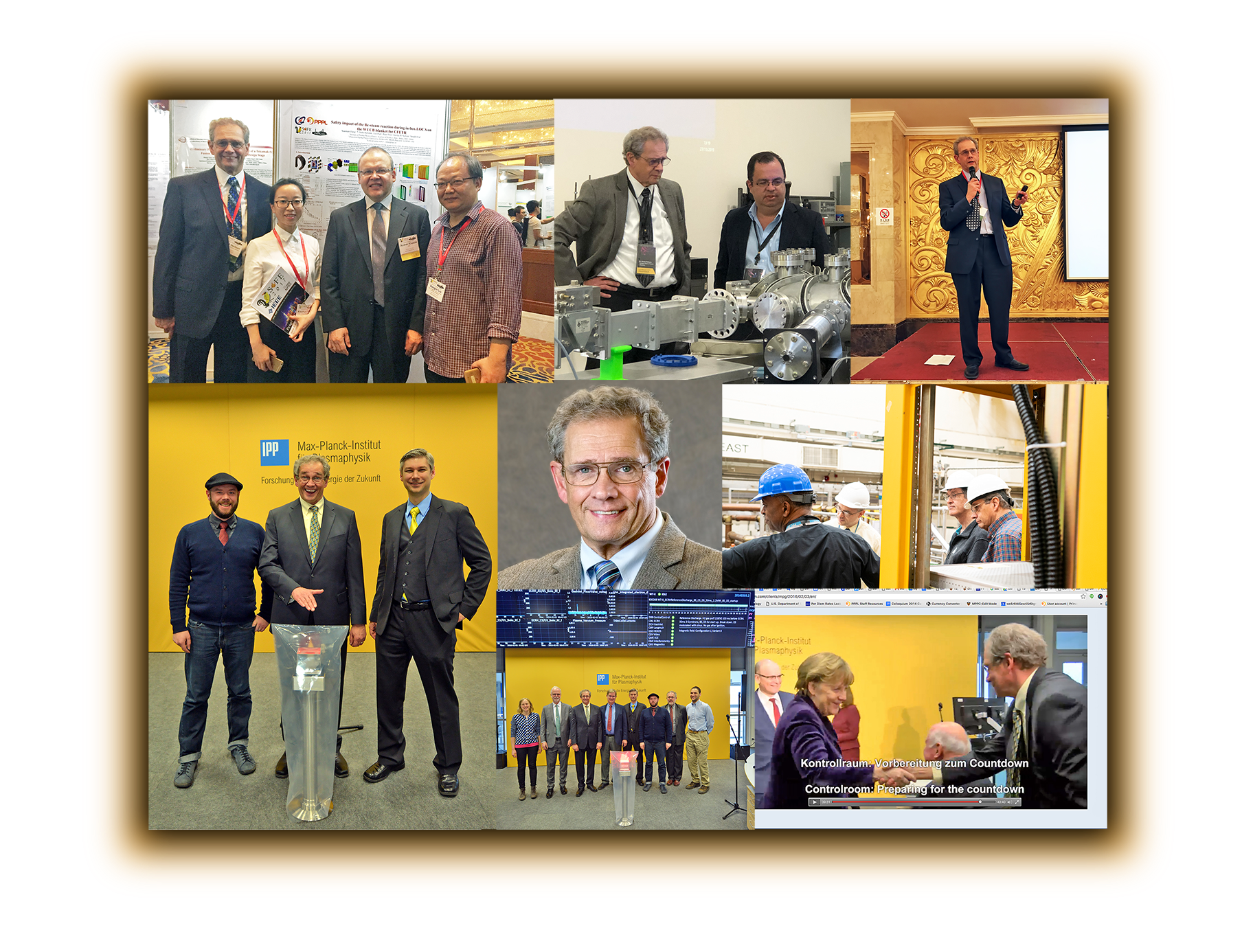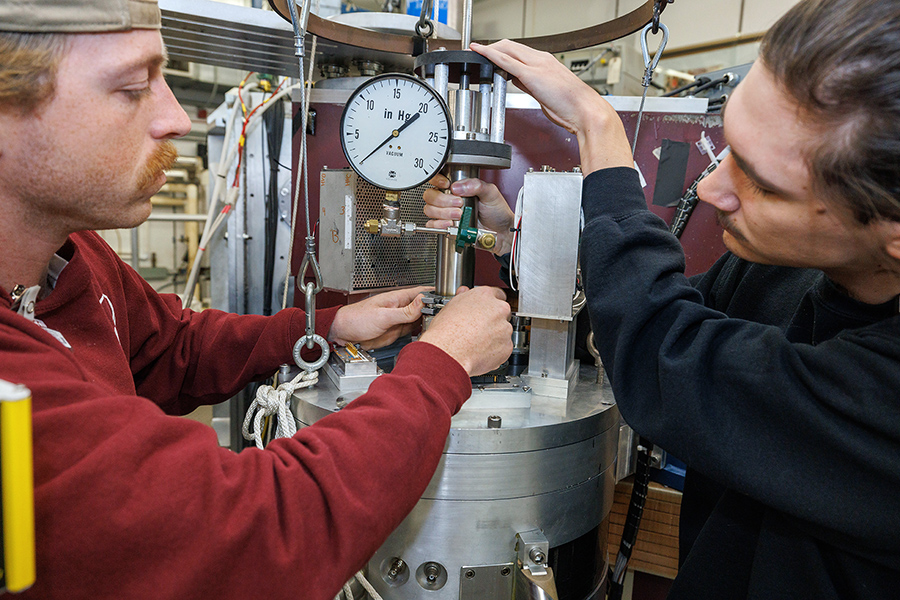The award, which recognizes “outstanding technical contributions to the field of nuclear and plasma sciences,” will be given to Neilson at the 2021 Symposium on Fusion Engineering (SOFE) conference May 31 to June 4, which will likely be postponed or virtual. The honor includes a $5,000 award.
“I’m so pleased the IEEE NPSS has recognized Hutch’s many achievements with this award,” said Steve Cowley, PPPL director. “He has made so many contributions to PPPL and to the international fusion community and continues to do so with his management of diagnostics for ITER on behalf of US ITER, which will be vital tools for researchers working on ITER.”
Neilson’s impact through numerous international and national fusion projects is far-reaching, said Michael Zarnstorff, PPPL chief scientist. “He’s been a leader in experiments, he’s been a leader in the community and in organizing these very large collaborations,” Zarnstorff said. “So he’s had a huge impact on the field.
Zarnstorff supported the nomination by Charles Neumeyer, the former chief engineer at PPPL who retired in 2019. “Hutch is eminently qualified to receive this award,” Neumeyer said. “He has made amazing contributions over his career, starting out in technical areas and then branching out to project management and policy decision-making. He’s had great influence on the success of the fusion program.”
Neilson, the head of ITER Projects, said he is honored by the recognition. “I’m touched. It means a lot because I’m a plasma physicist but I’ve spent my career managing teams of physicists and engineers,” Neilson said. “I like to think that it’s not just a recognition of me but it’s a recognition of what I’ve been trying to accomplish to support fusion engineering.”
Zarnstorff said Neilson has a talent for managing large collaborations on projects such as W7-X and U.S. contributions to ITER. “He’s strongly committed to his projects and brings a great deal of organization and focus,” Zarnstorff said. “He has insightful comments and perspectives and he thinks for himself . He’s also a generally upbeat guy. I find him a pleasure to work with.”
Overseeing diagnostics projects for US ITER
For the past several years, Neilson has overseen PPPL’s contributions to ITER Diagnostics on behalf of US ITER. In 2016, he took over from Neumeyer, who was needed elsewhere in the Laboratory, and oversaw the completion of a $34-million project to provide three-quarters of the electrical components for the steady-state electrical network for ITER, which concluded in October 2017 with the arrival of six truckloads of electrical supplies.
The PPPL team is currently focused on the design and fabrication of seven diagnostics that are part of the U.S. contribution through US ITER. The diagnostics are needed to measure the hot super-charged gas called a plasma under fusion conditions in which ITER will produce for the first time a self-sustaining or burning plasma.
Neilson said he and other members of his team enjoy working on the international project, which will pave the way for a next-step fusion pilot plant that will demonstrate the feasibility of producing fusion energy commercially. “We’ve got a team of really outstanding engineers from the Laboratory as well as some partners in other institutions that are also top drawer, so it’s exciting to learn from them.”
Neilson was an active member of the IEEE Fusion Technology Committee, for 16 years; the Committee is responsible for running the SOFE conference. He is chair of the technical program committee for the 2021 SOFE conference. He chaired the 2017 SOFE conference in Shanghai, and was technical program chair in 2013. In 2019, Neilson was senior editor of a special issue of the journal IEEE Transactions on Plasma Science, featuring papers from the SOFE-2019 Conference.
ResearchGate lists 157 publications that Neilson authored or co-authored. He edited a book, “Magnetic Fusion Energy: From Experiments to Power Plants,” (Woodhead Publishing, 2016), which introduces early-career researchers to fusion energy. Among his publications early in his career was an article he wrote with MIT’s Martin Greenwald and others, “A new look at density limits in tokamaks,” which introduced the concept of the Greenwald Limit, which describes one of the basic limits on the stability of tokamak plasmas.
A graduate of the Massachusetts Institute of Technology, with bachelor’s and master’s degrees in electrical engineering, Neilson received his Ph.D. in plasma physics from the University of Tennessee. He began his career at Oak Ridge National Laboratory working on the ORMAK (Oak Ridge TokaMAK), and the Impurity Study Experiment (ISX-A, and ISX-B) tokamaks and the Advanced Torroidal Facility (ATF) experiments during his 14-year career at Oak Ridge. It was there he first became interested in stellarators, fusion devices with twisted coils, as head of the Confinement Projects Section at Oak Ridge. “I got involved in project management at Oak Ridge,” Neilson recalled. “We were building a stellarator called ATF (Advanced Toroidal Facility), and I thought that I would be a better physicist if I understood a little bit more about the machine itself and the design and the engineering that went into it. I’m forever grateful to Oak Ridge.”
Neilson came to PPPL on assignment from Oak Ridge in 1989 to work as physics manager on the design of the Burning Plasma Experiment (BPX) and later the Tokamak Physics Experiment (TPX) . He became a member of the staff at PPPL in 1996. Although neither experiment was built, the design of the TPX was the basis for the Korean Tokamak Advanced Research (KSTAR) experiment and the Experimental Advanced Superconducting Tokamak (EAST) in China.
Neilson’s work as deputy head of PPPL Advanced Projects took him all over the world. He first worked as the physics operations team leader for the U.S. ITER Home Team for a year. He began the first of many projects with international collaborations as the team leader for the U.S. Physics Team collaborating on the conceptual design of KSTAR and with collaborators on EAST.
Neilson again focused on stellarators through his work with Zarnstorff as project manager of PPPL’s National Compact Stellarator Experiment (NCSX). Although the project was never completed, it contributed to knowledge of quasi-asymmetric stellarator design.
Neilson continued working on international projects as head of Advanced Projects at PPPL from 2009 to 2018. He was responsible for PPPL’s contributions to the W7-X stellarator in Germany. Neilson and his wife spent nine months in Greifswald, Germany, during commissioning of the device while Neilson was program manager and national coordinator for the W7‑X collaboration. Neilson and other PPPL and national laboratory and university collaborators were in Germany for the celebration of the W7-X first plasma in 2016, where he met German Chancellor Angela Merkel.
Neilson is a fellow of the American Physical Society’s Division of Plasma Physics and a Senior Member of IEEE. In addition to his work with the IEEE, he is a past member of the U.S. Fusion Energy Sciences Advisory Committee; a co-chair of the U.S. Magnetic Fusion Research Strategic Directions activity, a member and past chair of the DIII-D Program Advisory Committee; a member of the EAST International Advisory Committee, a member of the Technical Program Committee of the 2018 ANS Technology of Fusion Energy conference; and a founding member of the Technical Program Committee of the IAEA DEMO Programme Workshop series.
Neilson is typically modest about his current project. “There are some days where you say, ‘the whole project would have been better off if I hadn’t gone to work,’” he said. “Of course, you get into some situations that are frustrating when you’re trying to push forward. But you realize after a while that it’s a complex set of agendas and that’s part of your job as a leader to navigate your way through that as best you can.”
PPPL, on Princeton University’s Forrestal Campus in Plainsboro, N.J., is devoted to creating new knowledge about the physics of plasmas — ultra-hot, charged gases — and to developing practical solutions for the creation of fusion energy. The Laboratory is managed by the University for the U.S. Department of Energy’s Office of Science, which is the largest single supporter of basic research in the physical sciences in the United States, and is working to address some of the most pressing challenges of our time. For more information, please visit science.energy.gov.



